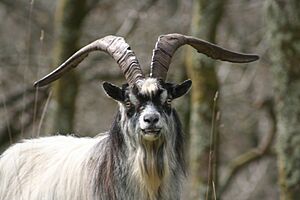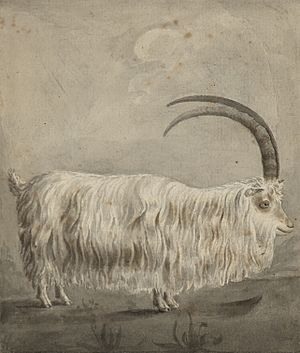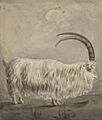British Primitive goat facts for kids
| Country of origin | United Kingdom |
|---|---|
| Traits | |
|
|
The British primitive goat is a special type of domestic goat found in Great Britain and Ireland. It's considered the original goat of this region. This goat is quite rare, with only about 1,200 left. You can find them in small, wild herds, in some zoos and nature reserves, and on farms run by people who love rare animals.
This goat is also called the British native goat, the old British goat, or the old English goat. It comes from the very first goats brought to the area around 3,000 BCE, during the Neolithic era. It's known for being small, tough, and having wiry hair. It can live and have babies on its own without much help from humans, even in rough weather and terrain. Some goats in Northumbria are called the Cheviot goat. The British primitive goat also helped create some modern goat breeds, like the Anglo-Nubian goat.
Contents
History of the British Primitive Goat
The British primitive goat includes what were once thought of as four different types:
- English primitive goat
- Irish primitive goat
- Scottish primitive goat
- Welsh primitive goat
These types were so similar that they are now grouped together. Some groups, like the UN Food and Agriculture Organization, believe some of these types are now gone.
How Goats Arrived in Britain
The ancestors of the British primitive goat arrived about 5,000 years ago. They came with the first farmers in the Neolithic period, around the time Stonehenge was built. These goats were small and could handle all kinds of weather. They gave early farmers milk, meat, skin, hair, and fat.
These goats were common among the Celtic and Germanic peoples of Northern Europe. They survived through the Bronze and Iron Age because they were strong and could find their own food in tough places. They didn't need much human help and were good at avoiding predators.
Goats Through the Ages
The goats continued to thrive as different groups settled in Britain, like the Anglo-Saxons and Vikings. During the Medieval period, they were the main goats kept on large estates. They even played a part in making Cheddar cheese.
Until the late 1700s, there were many British primitive goats. Scotland and Northern England had over a million, and Ireland had half a million. They were the only type of goat in the British Isles back then.
Why They Became Less Popular
Over time, these native goats became less popular. This was because they were small, had coarse hair, and large horns. Farmers started preferring foreign breeds from India, the Middle East, and Switzerland. These new breeds had shorter, smoother coats and produced more milk. They became the basis for the modern goat breeds we see today in the British Isles.
British Primitive Goats in the United Kingdom
The primitive goat might have disappeared in the UK if some hadn't escaped or been set free. These wild herds have been shrinking for a long time. This is because other types of goats took their place, and land where they grazed was turned into tree farms.
By the 1950s, many places that once had wild goats no longer did. Many goats were killed when forests were planted in their grazing areas. By the 1990s, even fewer herds were left, with only about 4,000 goats in total. More recently, large numbers of goats have been removed, sometimes 1,200 at a time.
Some farm groups and zoos are now working to help save the British primitive goat. They want to make sure a healthy number of these goats survive.
Current Status and Locations
A group called the British Feral Goat Research Group believes that only about 1,500 pure British primitive goats are left in Great Britain. This is because they have mixed with modern goat breeds. This makes them a rare breed. The group says it's urgent to protect these goats. They have convinced places like Windsor Great Park and Battersea Park Zoo to keep populations of the British primitive. Another large group lives in Galloway Forest Park.
Today, wild herds can be found in Northumberland, Snowdonia, and the Black Mountains. There are also some on Lundy Island. Smaller groups live in Somerset and on the Isle of Wight. Scotland has a larger population, mostly deep in the Highlands.
Even the Royal Society for the Protection of Birds keeps a small herd of these goats in Inversnaid, Scotland. Other nature reserves, like Mull of Kintyre, Colonsay, and Grey Mare's Tail, also have herds.
The Cheviot Goat
The goats living in the Cheviot Hills in Northumberland are called the Cheviot goat. People believe they have been wild there since at least the Iron Age, maybe even the Neolithic period. These goats have sometimes caused problems for nature lovers and local farmers.
In 2011, a project started to track them using GPS collars. This helps scientists understand where they roam and what they eat. This information will help manage them in the future. These goats don't have special legal protection, so landowners can remove them. This is a real threat to this small, special group of goats.
British Primitive Goats in Ireland
The Old Irish goat is the original and only native goat breed in Ireland. It arrived during the Mesolithic period and adapted to the cold weather. It became an important part of Ireland's history. This goat was easy to care for and helped many village communities during tough times. It is celebrated in Irish traditions, art, and stories.
The Old Irish Goat is now critically endangered. This is due to changes in farming, mixing with modern goats, hunting, and culling.
The Burren Mountains Herd
The Old Irish goat can be found in the Burren mountains. However, fewer than 10% of the wild herd (about 250 goats) are thought to be purebred. This is because they have mixed with Anglo-Nubian and Swiss goats. Recent DNA tests show that this group is genetically unique. But, it hasn't yet received official protection.
During the Great Famine, many goats were let loose because people couldn't feed them. After the famine, many were caught and herded into the mountains by landowners.
Puck Fair
There's an annual festival in Killorglin, Kerry, Ireland, called the Puck Fair. It lasts two days. During the fair, people catch a wild goat and put it on a stand in the town square. They call the goat "King Puck" and it's the honorary master of ceremonies. In old pagan Ireland, the goat was sacrificed. Today, it is set free at the end of the fair.
Characteristics of the British Primitive Goat
The typical British primitive goat has a strong, square body with broad shoulders and back. Its legs are shorter than its body and look bony, short, and straight. It usually has a long body and a thick, short neck. Its belly is rounded, and its lower back is broad and deep. The chest bone always sticks out.
Head and Horns
The goat's head gets narrower towards its nose. It has a noticeable forehead that is broad. Its face looks a bit sunken where the forehead meets the face. The ears are usually round, small, and stand upright. Male goats (bucks) have smaller ears than female goats (does). Sometimes, the ears point forward because of horn growth. A key feature of this breed is the beard, which is always present in both males and females.
The horns usually have a "scimitar" or "dorcas" twist. They grow high and parallel to the forehead. The horns are thick at the base and often wide apart. A female goat's horns are smaller and thinner. Some goats of this breed are born without horns, but it's not very common.
Size and Coat
These goats are relatively small. Male goats are about 24 to 27 inches (61 to 69 cm) tall at the shoulder. Female goats are about 22 to 24 inches (56 to 61 cm) tall. Both males and females often weigh around 100 to 120 pounds (45 to 54 kg). Their size can vary slightly depending on the region.
British primitive goats have long hair. A male goat's hair is usually even, while a female goat's hair can be thick or dense. Their hair is never smooth or shiny. The male's coat is long to very long, blending with his beard to form a fringe. A female's hair varies from thick to very thick, sometimes with longer fringes down her spine and around her sides. In winter, their hair becomes much thicker and denser. This is because of a soft under-wool called cashmere, which makes them look bulky.
Colors and Reproduction
Common colors and patterns in British primitive goats include white, tan, wild patterns, badger-face, grey, light-belly, black, red cheek, mahogany, and face mask. They can also have reverse stripes, belts, and spots (pied).
British primitive goats mate between August and December. The pregnancy period is about 150 days. Sadly, up to one-third of the baby goats (kids) die within the first few days. This is often due to predators like foxes, large birds like crows, and birds of prey.
Cross-breeding of British Primitive Goats
Besides wild populations mixing with imported goat breeds, British primitives have also been used in planned breeding by humans.
The old English type, in particular, is one of the original breeds used to create some modern, standardized goat breeds. For example, the popular Anglo-Nubian goat started in England in the 1920s–1930s. It was created by mixing old English milk goats with other breeds.
Images for kids





